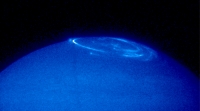- Home
- Science
- Research Groups
- Research Topics
- Annual Report
- Education
- Agenda
- Public & Media

- Contact Us
de Géophysique (Bât. B5c)
Quartier Agora
Allée du 6 août, 19C
B-4000 Liège 1 (Sart-Tilman)
Belgique
Tel.: 04.366.9779
Fax: 04.366.9729
Research Topics
Planets

Our solar system officially counts 8 planets. The four planets that are
nearest to the Sun; Mercury, Venus, Earth and Mars are rocky bodies, while
the four farthest ones are gaseous planets. All of them bear an atmosphere,
eventually tenuous, which characteristics depend on the planet size, position
and evolution.
Researches conducted at the Laboratory for Planetary and Atmospheric Physics
(LPAP) focus on the physical and chemical processes
occurring in the upper atmospheres of Venus, Mars, Jupiter and Saturn.
They take advantage of planetary spacecraft like Venus Express, Mars Express
and Galileo (Jupiter) and Cassini (Saturn) missions. Data collected with the
different instruments are used to compare the atmospheric conditions between
them in view of what is observed at Earth.
Apart from Venus and Mars, all solar system planets generate their own magnetic
field. Their interaction with the solar wind gives rise to a magnetic cavity,
called the magnetosphere, protecting the planet from the solar particles
onslaught. The presence of, often fierce, phenomena inside the magnetosphere
may leave visible signatures in the planetary atmosphere. They take the form
of polar aurorae.
The LPAP studies Jupiter's and Saturn's ultraviolet aurorae and their connection
with the magnetosphere-ionosphere coupling. Additionally to Galileo and Cassini
data, researchers are regularly involved in observing campaigns with the
Hubble Space Telescope.



 Version française
Version française